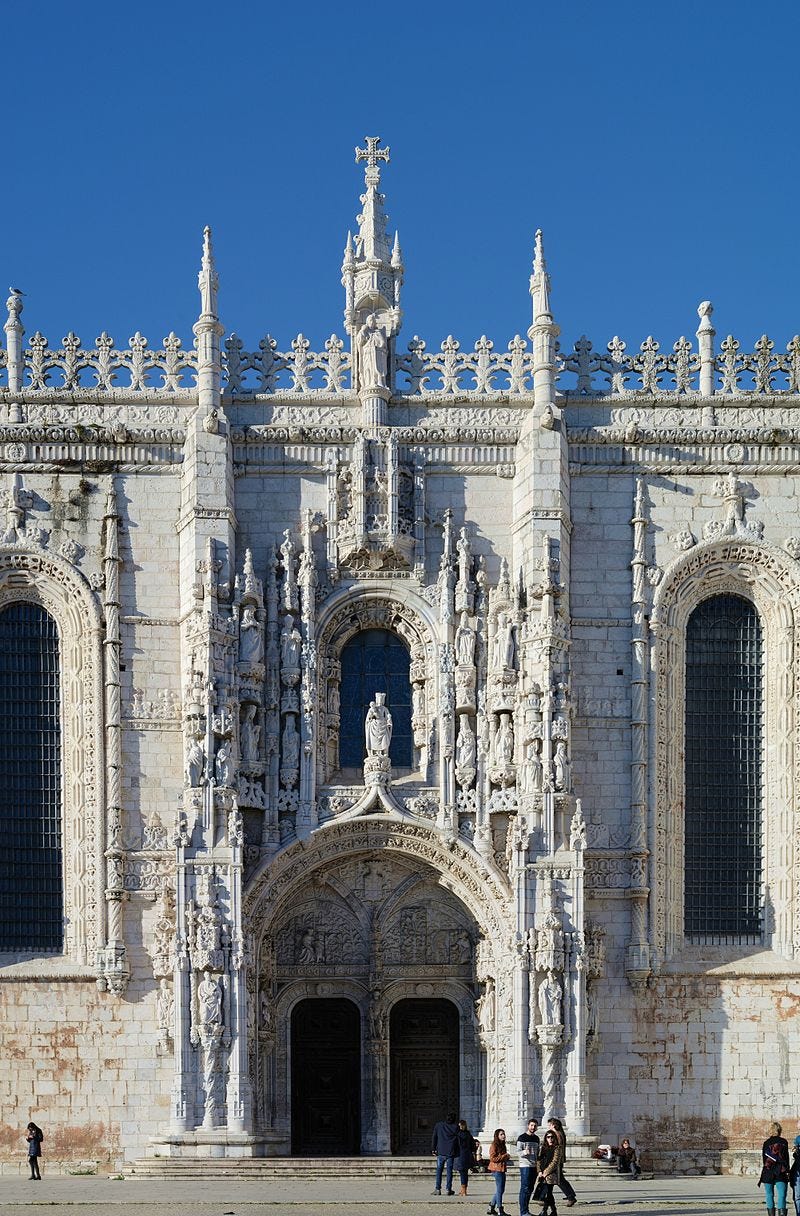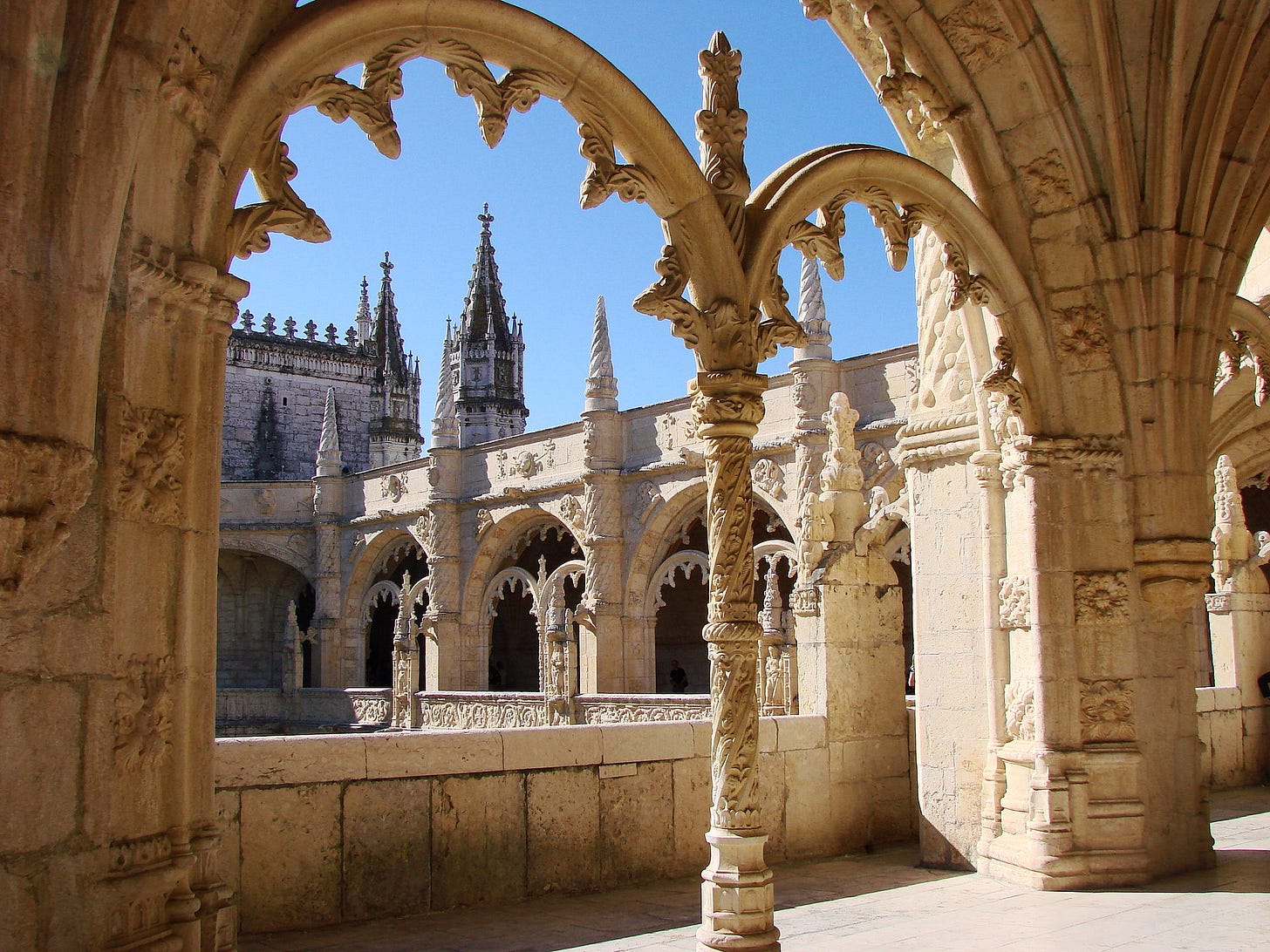Lisbon, Portugal and surrounds—3 Historical Places to Visit
Welcome to Issue XXVI of Historical Architecture Destinations! Today we're diving into three historical places to visit in Lisbon, Portugal and the surrounding area.
Origins: The Phoenicians
Archaeological evidence has dated Phoenician presence here to as early as 1200 BC.
And the origins of the city’s name steeped in legend are nearly as old.
What’s in a name?
According to local legend, the name Lisbon (originally Olissipo) comes from the mythical Ulysses (the hero of Homer’s Odyssey) who is said to have founded the city.
In 202 BC after Hannibal was defeated, Hispania (the Iberian Peninsula) was incorporated into the Roman province of Lusitania (present day Portugal and Western Spain). The city prospered under the Romans and many Roman temples, a wall and a theater were built. In the 4th century a Catholic presence was established in Lisbon.
After the fall of the Western Roman empire the city was ruled by different Germanic tribes.
In the 8th century the city was taken by the Moors. The Moors withstood several attacks by Crusader forces until it fell in 1147 to Afonso I (first King of Portugal).
A few centuries later brings us into the Age of Discovery and leads us to our first building.
1. Jerónimos Monastery
The Age of Discovery was at its height under late 15th century King Manuel I. At the end of the 15th century Manuel I requested permission to have a monastery built on top of the earlier church Santa Maria de Belém.
This previous church was home to monks of the Military Order of Christ (a successive Knights of Templar) who provided help to seafarers in transit. Vasco da Gama the famous Portuguese explorer prayed at the chapel before setting out on his voyage in 1497. Originally intended as a burial place for members of the royal family but after da Gama’s discovery of a sea route to India the building’s intent was changed to also honor the Portuguese explorers.
Construction of the monastery began in the early 16th century and was completed nearly a century later.
The style sometimes called late Portuguese Gothic is now known as Manueline and is particularly ornate. The monastery also has Spanish Plateresque influences that includes intricate ornamentation. The two-story cloisters were unusual for the time but make the monastery even more majestic.
The building withstood the 1755 great earthquake of Lisbon with little damage.
The monastery was secularized in 1833 and restoration work began in the late 17th century. Today you can visit this jewel of Portuguese architecture through the church and monastery.
Jerónimos Monastery along with our next building represent the Portuguese Age of Discovery.
2. Tower of Belém
Also built at the behest of King Manuel I this fortified defensive tower is a symbolic gateway to Lisbon.
Situated on the northern bank of the Tagus river the tower is 100ft (30m) high and was completed in 1519. The four stories of the tower are considered part of Portuguese Late Gothic style or Manueline style. The cross of the Order of Christ represented the military power and can be seen throughout the structure.
The ground floor is home to the cannon room with cannons positioned ready to fire against invading ships.
The levels above the cannon room were used for various official functions over the centuries. And from the top you can see the Tagus river and the Belém neighborhood. Together with the Jerónimos Monastery they make up Lisbon’s only UNESCO World Heritage Site.
Traveling 30 minutes northwest of the city is our next building.
3. Quinta da Regaleira
Near the historic center of Sintra lies this estate much of which was completed in 1910.
Once belonging to the Viscountess of Regaleira it was sold in 1892 to Carvalho Monteiro. With the help of Italian architect Luigi Manini he constructed several buildings on the vast estate that include a Palace, Chapel, Tunnels, and Wells. The Wells were never used as water sources but rather for ceremonial purposes.
The enigmatic structures reflect Monteiro’s interests including the Knights Templar.
Some believe the Wells were used as Initiation Wells. The larger of the two wells contains an 88ft (27m) spiral staircase. Legend has it that the nine flights of stairs could be linked to the nine founders of the Knights Templar.
At the bottom of the well is the Templar cross.
This fascinating site makes up part of the UNESCO World Heritage site the Cultural Landscape of Sintra.
Present Day
Today Lisbon is a global city rich in architecture and culture with its historic presence seamlessly woven together into a contemporary city.
Deep Dives
For an account of Vasco da Gama’s voyages check out the riveting historical epic The Last Crusade: The Epic Voyages of Vasco da Gama by Nigel Cliff.
And for a captivating journey through Portugal’s discovery of a sea route to India and domination over the spice trade check out the NY Times bestselling author Roger Crowley’s take in the Conquerors: How Portugal Forged the First Global Empire.
*As an Amazon Associate I earn from qualifying purchases.
Architecture Atlas the website is now live 🥳
Although still in its infancy, this site is a place to discover the world’s architectural wonders. You’ll find stories about historical sites, maps of historical architecture destinations and more.
What can you find on the website?
✦ Stories about the wonders
✦ Maps of destinations
Coming soon
✦ Drawings
✦ Itineraries
I’ll be adding the over 70 architectural sites that I’ve already written about and itineraries for select destinations as well. I’d love to hear what you think.
Congratulations, you made it to the end!
Thank you for subscribing and reading. I would love to hear your feedback. And if you enjoyed the issue, please share it with your friends and family.
My goal:
To inspire people to awaken their sense of wonder by experiencing the beauty in this world ✨
To get daily updates about the world’s architectural wonders follow me on Twitter.









